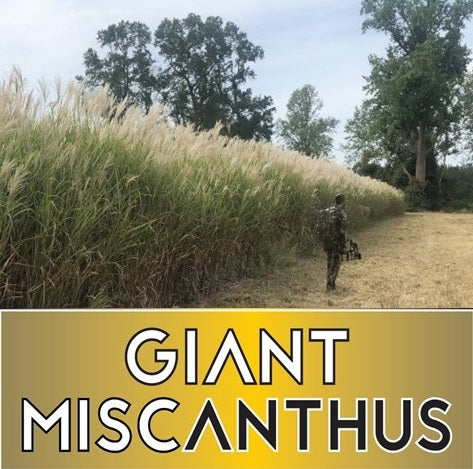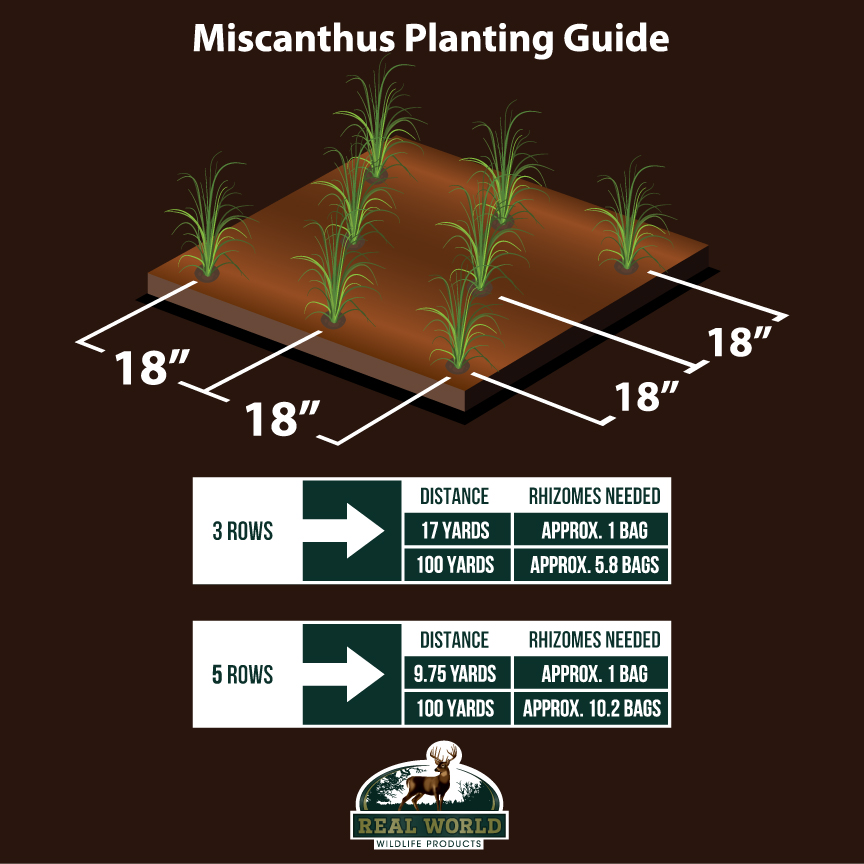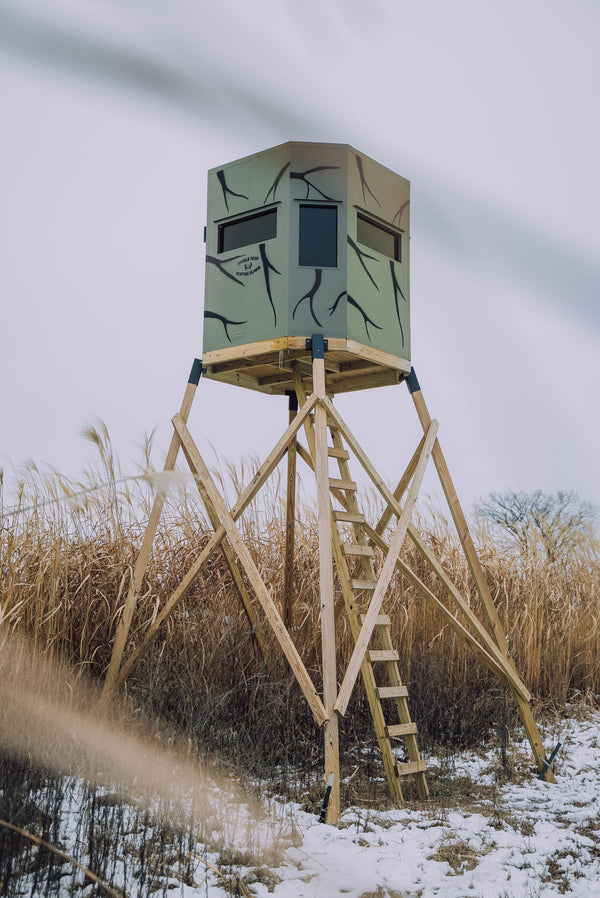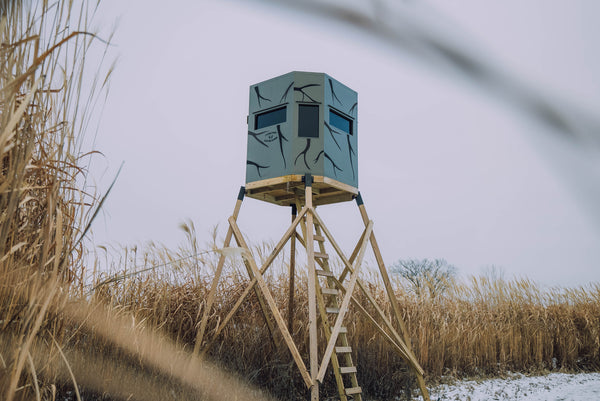
Real World Giant Miscanthus
Tax included
MISCANTHUS NOW AVAILABLE FOR PRE-ORDER FOR 2026 SEASON
GET FREE SHIPPING ON YOUR PRE-ORDERS
MISCANTHUS WILL BE SHIPPED IN APRIL AND MAY
Real World Giant Miscanthus grows between 12 and 15 feet tall, reaching full maturity in three years. It’s ideal for adding structure within switchgrass bedding areas, creating borders around food plots, and blending seamlessly into hunting blinds. To achieve effective screening and privacy, we recommend planting at least three rows. Many customers also use this versatile grass to enhance privacy around homes, campsites, and between neighboring properties.
ANSWERS TO COMMON QUESTIONS:
How does it perform in areas prone to flooding?
This variety does not perform well in saturated soils and is sensitive to excessive moisture. For areas prone to wet conditions, Real World Switchgrass is a more appropriate choice.
What amount of sunlight is necessary for optimal growth?
Consider Real World’s Giant Miscanthus similar to corn in terms of growing requirements. Both Giant Miscanthus and corn need full sunlight, sufficient rainfall, and minimal competition from trees, weeds, and other plants.
Is it permissible to dig up and transplant rhizomes to different locations?
The Giant Miscanthus offered by Real World is a patented cultivar protected by patent laws. Real World operates under the supervision of the patent holder, who requires reporting of sales exceeding certain volumes. This is similar to patented agricultural seed technology, where harvested grain seed cannot be replanted.
How many Real World Giant Miscanthus Rhizomes do I need?

ABOUT REAL WORLD GIANT MISCANTHUS:
For many years, our customers have inquired whether Real World would introduce a plot screening product. We evaluated numerous annual plant species, but none met the rigorous standards required to carry the Real World name. Although some appeared promising during growth and early fall, they ultimately collapsed after dying. We chose not to offer any product that we knew would fail to meet performance expectations.
Several years ago, Real World Wildlife Products president Don Higgins planted miscanthus grass on his farm and was highly impressed by its potential for wildlife land management. Motivated by this, he dedicated significant time to studying this exceptionally tall grass. Upon learning about the various miscanthus varieties, he organized visits for the Real World team to university, corporate, and private test plots nationwide. After evaluating numerous cultivars, the team selected one variety they believed was ideal for screening and habitat purposes. They then negotiated with the patent holder and secured a contract to market this specific cultivar. It’s important to note that Real World Giant Miscanthus stands apart from other miscanthus types—it grows as tall as any but features more foliage, providing superior screening. Dare to compare!

What is miscanthus?
Miscanthus is a woody perennial grass native to Asia, commonly reaching heights over 12 feet. It features bamboo-like stalks averaging 3/8 inch in diameter. This non-invasive grass does not produce viable seeds. Due to its high yield per acre, miscanthus is primarily cultivated for biofuel production. It is cold-hardy, grows quickly, requires minimal nutrients, and is resistant to most pests and diseases.
How should I store my miscanthus rhizomes?
We strongly encourage you to have your planting site ready and plant your rhizomes as soon as possible after receiving them. Rhizomes can be stored for 2-4 weeks in a refrigerated storage unit. The colder temperatures keeps the rhizomes dormant and slows the growth. Do not put rhizomes in the freezer.
Using Real World Giant Miscanthus on my property?
Miscanthus rhizomes should be planted in the spring once the soil can be worked. A well-tilled bed does help the roots establish quicker, but is not necessary. The rhizomes should be planted 4” deep and spaced 18” apart in rows that are spaced 18”-24” apart. Remember, every year these plants will expand approximately 4″ in each direction. Good results can be achieved on a wide range of soils but the key is moisture. Adequate moisture and 60° ground temperature will promote good growth. Miscanthus can tolerate a wide range of soil pH but performance is best between 5.5 and 7.5 pH. Sandy soils only yield well if rainfall is adequate due to its dry nature. Weed control is important during establishment. Do not worry as much about grass competition, but more so with broadleaf weeds during the first year of establishment. Most common corn herbicides will be fine to use on miscanthus – Dual, Atrazine, 2,4-D etc. It is a good idea to spray a herbicide like atrazine right after planting your rhizomes in a weed-free seed bed.
How should I store my miscanthus rhizomes?
We strongly encourage you to have your planting site ready and plant your rhizomes as soon as possible after receiving them. Rhizomes can be stored for 2-4 weeks in a refrigerated storage unit. The colder temperatures keeps the rhizomes dormant and slows the growth. Do not put rhizomes in the freezer.
Miscanthus is propagated by planting sections of root known as rhizomes, as it is sterile and cannot be grown from seed. Plant the rhizomes approximately 4 inches deep, spacing them 18 inches apart within rows, with rows spaced 18 to 24 inches apart. Each plant will expand 4 to 6 inches annually, gradually filling in the rows to form a dense hedge. For effective screening, it is recommended to plant 3 to 5 rows.
What kind of growth should I expect from my Real World Giant Miscanthus?
In the first year, each rhizome typically produces 1 to 3 stalks ranging from 1 to 8 feet tall, depending on soil, weather, and location. By the second year, expect 5 to 7 stalks per plant, growing between 4 and 12 feet tall. In the third year, each cluster should reach about 14 inches in diameter with 20 to 25 stalks standing 10 to 12 feet tall. After this, clusters will begin to merge, filling in gaps. These are average estimates, and actual growth may vary based on your specific conditions. By year three, you can expect excellent screening cover, though adequate coverage may occur earlier.
How do I maintain my miscanthus and should I fertilize?
Fertilizer demands are minimal, but applying a moderate amount about a month after planting encourages growth in both rhizomes and stalks. Use a standard triple-12 or triple-15 fertilizer for this purpose. After the first year, only small nutrient applications every two to four years are necessary to maintain healthy yields. Apply these follow-up fertilizers in late winter or early spring. If possible, burn your miscanthus every 2 to 3 years in early spring to remove old thatch, control weeds and tree saplings, and stimulate vigorous growth. While mowing is an alternative, burning is far more effective for sustaining a strong stand.
How can I create the best screen possible on my hunting property?
For years, Real World customers have relied on Real World switchgrass for creating effective screening cover. Now, with Real World Giant Miscanthus, you can combine these two tall grasses to build the ultimate screen. Begin the fall before planting by preparing a 12 to 15-foot-wide seed bed in your desired location. In late winter, frost-seed Real World switchgrass into the seed bed at a rate not exceeding 4 pounds per acre. Early in spring, plant three rows of Real World Giant Miscanthus within the same seed bed: one row down the center and two rows spaced 2 to 3 feet on either side. Control weeds during the first year by applying atrazine at 1 quart per acre as early as possible in spring. If broadleaf weeds appear later in summer, treat with 2-4D. Once established, this combination will provide one of the most effective natural screens available, short of a solid wall.
If you are cancelling a preorder there will be a 20% processing fee as pre-orders have been placed with our distributors at the time of purchase.











